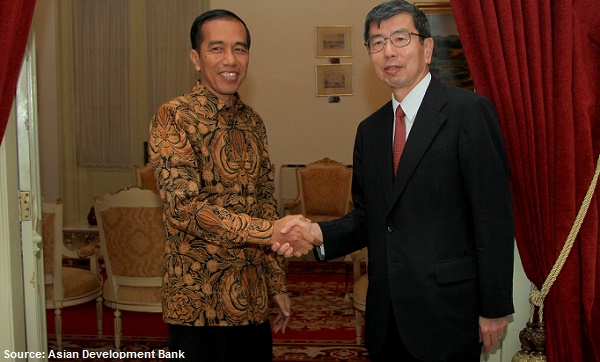Asian Development Bank: Economic Growth Asia Undimmed by Brexit
The Asian Development Bank (ADB) said economic growth in developing Asia is relatively untouched by the recent "Brexit" vote (Britain's decision to exit the European Union). The ADB only cut its outlook for economic growth in developing Asia by 0.1 percentage point to 5.6 percent (y/y) in 2016. Within a two-week period Asia's emerging market stocks and currencies pared the heavy losses that occurred around 23 June 2016 when - amid heightened concern about the global economy - a flight to safety emerged.
While "Brexit" had a clear impact on emerging market stocks and currencies, the Manila-based Asian Development Bank (ADB) sees limited influence of Brexit on the real economies of these markets. Meanwhile, disappointing economic growth in the USA so far this year is not expected to impact too drastically on growth in developing Asia. As such, ADB believes that the prospects remain largely in line with forecasts set in the March edition of the Asian Development Outlook 2016. However, ADB Chief Economist Shang-Jin Wei, said the tepid growth prospects in the world's major industrial economies should make policy makers remain vigilant and prepared to respond to external shocks to safeguard robust economic growth in the region.
China - the world's second-largest economy - remains on track to meet the ADB's growth forecast of 6.5 percent (y/y) in 2016 and 6.3 percent (y/y) in 2017 as the government is expected to continue fiscal and monetary stimulus measures to boost the local economy. Meanwhile, East Asia is estimated to expand by 5.7 percent (y/y) in 2016, followed by a 5.6 percentage point (y/y) growth in 2017.

The other Asian engine, India, has shrugged off global headwinds and is expected to expand by 7.4 percent (y/y) in 2016 and 7.8 percent (y/y) in 2017 on the back of brisk consumer spending and growth in the rural economy. According to the ADB, South Asia - as a whole - will be the region’s fastest growing area.
The ADB maintained its growth forecasts for Indonesia in 2016 and 2017 at 5.2 percent (y/y) and 5.5 percent (y/y), respectively. Indonesia's GDP growth was recorded at 4.9 percent (y/y) in the first quarter of 2016, supported by strong private consumption and investment. Controlled inflation (due to stable administrative prices for fuel, liquefied petroleum gas, and electricity) as well as a strengthening rupiah rate managed to support private consumption. Meanwhile, government consumption expanded by 2.9 percent (y/y). This growth pace is in line with the historically low spending pattern in the first quarter of the year. The ADB expects Indonesia's private consumption to pick up slightly in the period ahead on the back of moderate inflation, the stable rupiah, and an April cut in energy prices. Purchasing power and household consumption will also improve in Indonesia on the announced 50 percent increase in the threshold for liability to personal income tax in 2016 as well as a 14th monthly salary payment for civil servants. Although Indonesians' consumer confidence rose in the first four months of 2016, other high-frequency consumption indicators remain mixed.
Regarding Southeast Asia, the only market that saw a cut in its GDP growth outlook is Vietnam. The ADB expects the worsening drought to cause a contraction in the agricultural sector.
Asian Development Bank (ADB) Growth Forecasts Asia:
| Country/Region | 2015 | 2016F | 2017F |
| Developing Asia | 5.9% | 5.6% | 5.7% |
| Central Asia | 2.1% | 2.8% | 2.7% |
| East Asia | 6.0% | 5.7% | 5.6% |
| China | 6.9% | 6.5% | 6.3% |
| Hong Kong | 2.4% | 1.5% | 2.0% |
| South Korea | 2.6% | 2.6% | 2.8% |
| South Asia | 7.0% | 6.9% | 7.3% |
| India | 7.6% | 7.4% | 7.8% |
| Southeast Asia | 4.4% | 4.5% | 4.8% |
| Indonesia | 4.8% | 5.2% | 5.5% |
| Malaysia | 5.0% | 4.2% | 4.4% |
| Philippines | 5.9% | 6.0% | 6.1% |
| Singapore | 2.0% | 2.0% | 2.2% |
| Thailand | 2.8% | 3.0% | 3.5% |
| Vietnam | 6.7% | 6.3% | 6.5% |
| Pacific | 7.1% | 3.9% | 3.0% |
Source: ADB
Where do you see Indonesia's economic growth in full-year 2016?
Voting possible: -
Results
- Between 5.0% - 5.2% (55%)
- Between 5.2% - 5.4% (19%)
- Below 5.0% (15.5%)
- More than 5.4% (10.5%)
Total amount of votes: 611
-

